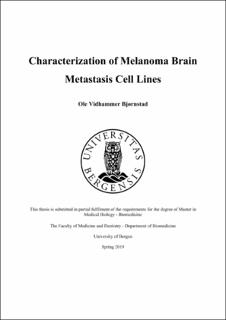Characterization of Melanoma Brain Metastasis Cell Lines
Master thesis
Permanent lenke
https://hdl.handle.net/11250/3126378Utgivelsesdato
2019-06-03Metadata
Vis full innførselSamlinger
- Master theses [33]
Sammendrag
Brain metastasis is a major public health problem. Metastatic brain tumors are ten times more common than that of all other primary brain tumors combined. The estimated annual incidence in Europe is around 1.5 million cases per year and is increasing at an alarming rate. The majority of brain metastases originate from cancers in lung, breast or skin (melanoma). Untreated, the median survival time is around 1 month, while aggressive treatment (combinations of surgery, chemotherapy, radiotherapy and radiosurgery) extends survival to around 4 months. In order to study the brain metastatic process, suitable animal models are needed. In this thesis, I developed several tumor/novel model systems, by injecting human patient derived metastatic tumor cell lines from melanoma intracardially into nod/scid mice. The tumor take in the mouse brains varied, depending on cell type. In H2 injected mice, all 5 mice developed one large and 1-5 small brain metastases, all with circumscribed borders. All H3 injected mice died shortly after injection of the cancer cell suspension. The one surviving mouse injected with the H5 cell line and the one surviving mice injected with H9 cells did not develop tumors. The H6 cell line proliferated too slow in vitro to produce enough cells for intracardial injections. Three of the H10 injected mice produced a large number of tumors with low tumor volumes. All Melmet 1 injected mice developed brain metastases, with four of them developing a large number and volume of tumors. All Melmet 5 injected mice developed brain metastases, however less in numbers and volumes than seen in Melmet 1 injected mice. The mutational analysis showed that all 7 cell lines harbored BRAF mutations (6-BRAFV600E, 1-BRAFL577F), and to various degrees, mutations in CDKN2A, NRAS, PTEN and TP53. A cell proliferation assay showed that the in vitro growth characteristics of the cells correlated to the growth patterns seen in vivo. A cell cycle assay by flow cytometry demonstrated that the Melmet 1 and 5 cell lines were in a relatively high S-phase percentage value compared to the H2 and H10 cell lines. An apoptosis assay by flow cytometry was used to check if there were any abnormal apoptotic tendencies in vitro, however this was not observed. In conclusion, four novel melanoma brain metastasis models using the H2, H10, Melmet 1 and Melmet 5 cell lines have been developed and characterized.
